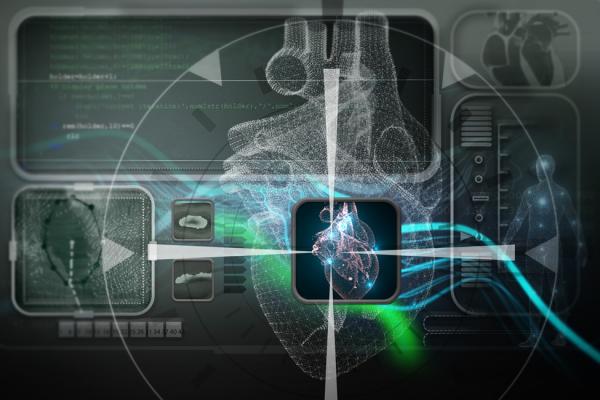
Using human AFib simulations, the researchers demonstrated that their technique can stop the catheter at the right target and identify the source type with a 95.25 percent success rate. This new algorithm also is effective in scarred tissue, which makes ablation more challenging, and has a 99 percent detection rate regardless of the scar size. Image courtesy of Florida Atlantic University.
May 28, 2019 — Researchers have developed the first algorithm that can locate patient-specific ablation targets for atrial fibrillation (AFib) within the atria that does not require specialized catheters or 3-D electro-anatomic maps of the heart. The new algorithm – the iterative catheter navigation (ICAN) – is fundamentally different from existing approaches.
Patients with AFib experience chaotic electrical signals in the upper chamber of their heart (atria), which cause an irregular or quivering heartbeat (arrhythmia) that can lead to blood clots and heart failure. AFib also is a major cause of stroke and affects 33 million people worldwide.
When medications and other treatments fail, electrophysiologists turn to ablation, which involves a catheter that is gently guided to the heart to destroy malfunctioning tissue and scar the problematic areas. Prior to surgery, electrophysiologists require advanced 3-D mapping of the heart to direct them to problematic areas, which is a laborious and time-consuming process.
This procedure also poses a number of challenges for physicians including low, long-term success rates, which requires a need for new techniques to successfully guide catheter movements and accurately detect AFib targets.
In the study from Florida Atlantic University’s College of Engineering and Computer Science and collaborators, published in the journal Cardiovascular Engineering and Technology,1 the researchers demonstrate that ICAN stops the catheter when it finds the AFib source and identifies the source type with a success rate of more than 95.25 percent using human AFib simulations. Researchers also tested the effectiveness of ICAN in the presence of fibrosis and patchy myocardial scars, which makes AFib source detection more challenging, with a 99 percent detection rate regardless of the scar size, using human Afib simulations.
ICAN iteratively navigates a catheter toward AFib sources, does not involve electrophysiological mapping of the entire surface of the heart, and does not make any assumptions on the AFib source types to navigate the catheter. As a result, this algorithm can be used for locating different types of AFib sources such as rotational circuits and focal beats.
“We have developed the first algorithm to localize atrial fibrillation sources by iteratively navigating a 20-electrode circular catheter that is routinely used for ablation procedures,” said Behnaz Ghoraani, Ph.D., senior author, an assistant professor in FAU’s Department of Computer and Electrical Engineering and Computer Science, and a fellow of FAU’s Institute for Sensing and Embedded Network Systems (I-SENSE) and FAU’s Brain Institute (I-BRAIN), two of the university’s four research pillars. “ICAN guides the incremental movements of this catheter from an arbitrary initial placement on the atrial tissue until a source of arrhythmia, rotor or focal, is detected by the algorithm.”
Ghoraani and collaborators from the Rochester Institute of Technology, the University of Rochester Medical Center and SUNY Upstate Medical Center tested ICAN on realistic simulated data with several test cases of rotor and foci-driven arrhythmias, which covered a broad range of activation patterns in 2-D as well as 3-D AFib simulations. They placed the catheter on 114,921 initial catheter locations across the simulated region for different rotor and foci mechanisms. In all cases, they modeled globally distributed fibrosis.
“Professor Ghoraani and her collaborators have developed a cutting-edge technique that has the potential to be a game-changer in how electrophysiologists treat atrial fibrillation with ablation,” said Stella Batalama, Ph.D., dean of FAU’s College of Engineering and Computer Science. “The high performance of this algorithm is evident by the high source detection success rate. ICAN could significantly improve the success of patient-specific atrial fibrillation ablation and facilitate treating patients before the disease progresses to the permanent stage.”
In addition, the researchers have demonstrated the feasibility of their study in a few human clinical AFib cases and plan to further validate ICAN in more patients. There are currently two patents pending for certain aspects of the algorithm.
For more information: www.springer.com/engineering/biomedical+engineering/journal/13239
Reference


 October 13, 2025
October 13, 2025 









